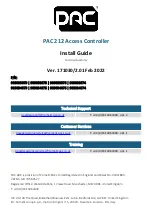
UG-1828
Preliminary Technical Data
Rev. PrC | Page 158 of 338
The above example uses Rx gain correction table. The similar algorithm applies to generate the new Rx gain compensation table with only
one difference: the digital gain should also compensate the LNA attenuation besides the front end attenuation therefore based on the
External Gain control word setting, the digital gain needs to be further adjusted.
Note LNA must be powered down for initial calibrations. Once it is configured or bypassed during radio on operation, it cannot be
dynamically configured or bypassed.
To accurately apply the attenuations for different components in the data path, user needs to measure the external path delay associated
with LNA and set the delay through API command adi_adrv9001_Rx_ExternalLna_DigitalGainDelay_Set(). More details about how to
measure the external LNA delay will be provided in the future.
As mentioned, two AGPIO pins are used for each receiver to perform external gain control. Depending on the hardware register setting,
the AGPIO pins for Receiver 1 and Receiver 2 can be selected from AGPIO[3:0], AGPIO[7:4] and AGPIO[11:8]. Table 58 shows an
example of Receiver 1 and Receiver 2 external gain element control when AGPIO[0:3] is selected (Note it is also possible to use
AGPIO[1:0] for Receiver 2 and AGPIO[3:2] for Receiver 1. Please refer to GPIO section in the User Guide for more information.).
Table 58. An Example of Analog GPIOs for External Gain Element Control
Receiver
AGPIO Pins to Control External Gain Element
Rx1
AGPIO[1:0]
Rx2
AGPIO[3:2]
These AGPIOs must be enabled as outputs and set for external gain functionality. The 2-bit value programmed is directly related to the
status of these AGPIO pins. For example: if the external gain word of the Receiver 1 gain table is programmed to 3 in selected gain index,
then AGPIO[0] and AGPIO[1] will be high if AGPIO[1:0] is used to control external gain element as the example show in Figure 149.
Figure 149. AGPIO Control of an External Gain Element to Rx1
GAIN CONTROL MODES
The gain control mode is selected through the API function adi_adrv9001_Rx_GainControl_Mode_Set() for a specified channel. Please
refer to API doxygen document for more details.
adi_adrv9001_RxGainControlMode_e is an enum for selecting the gain mode. The possible options are shown in Table 59.
Table 59. Definition of adi_adrv9001_RxGainControlMode_e
ENUM
Gain Mode
ADI_ADRV9001_RX_GAIN_CONTROL_MODE_SPI
Manual Gain Control SPI Mode
ADI_ADRV9001_RX_GAIN_CONTROL_MODE_PIN
Manual Gain Control PIN Mode
ADI_ADRV9001_RX_GAIN_CONTROL_MODE_AUTO
Automatic Gain Control Mode
adi_common_ChannelNumber_e is an enum which indicates which Rx channel is used:
Table 60. Definition of adi_common_ChannelNumber_e
ENUM
Rx channel
ADI_CHANNEL_1
Rx1
ADI_CHANNEL_2
Rx2
Automatic Gain Control (AGC)
In Automatic Gain Control (AGC) mode, a built-in state machine automatically controls the gain based on user defined configuration.
The AGC can be configured to one of two modes:
•
Peak Detect mode, where only the peak detectors are used to make gain changes.
EXTERNAL
ATTENUATOR
Rx1
AGPIO[0]
AGPIO[1]
24159-
107
















































